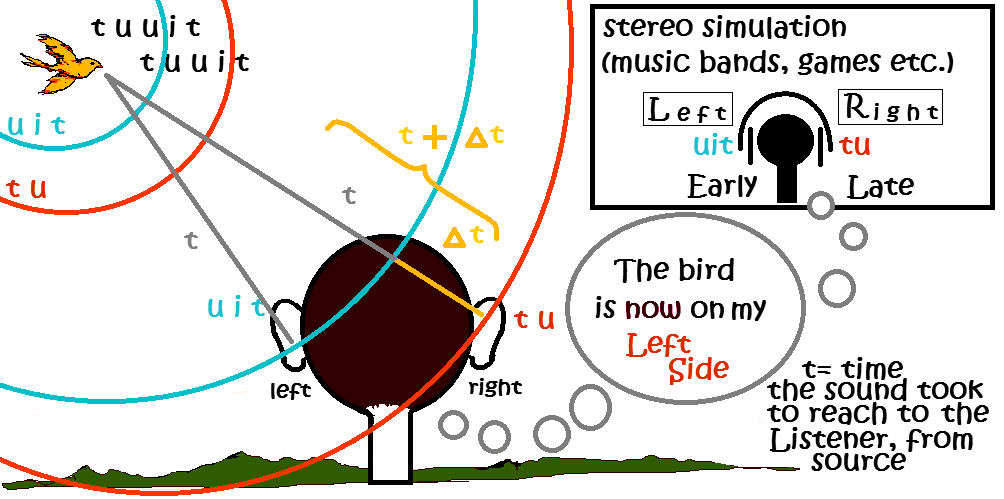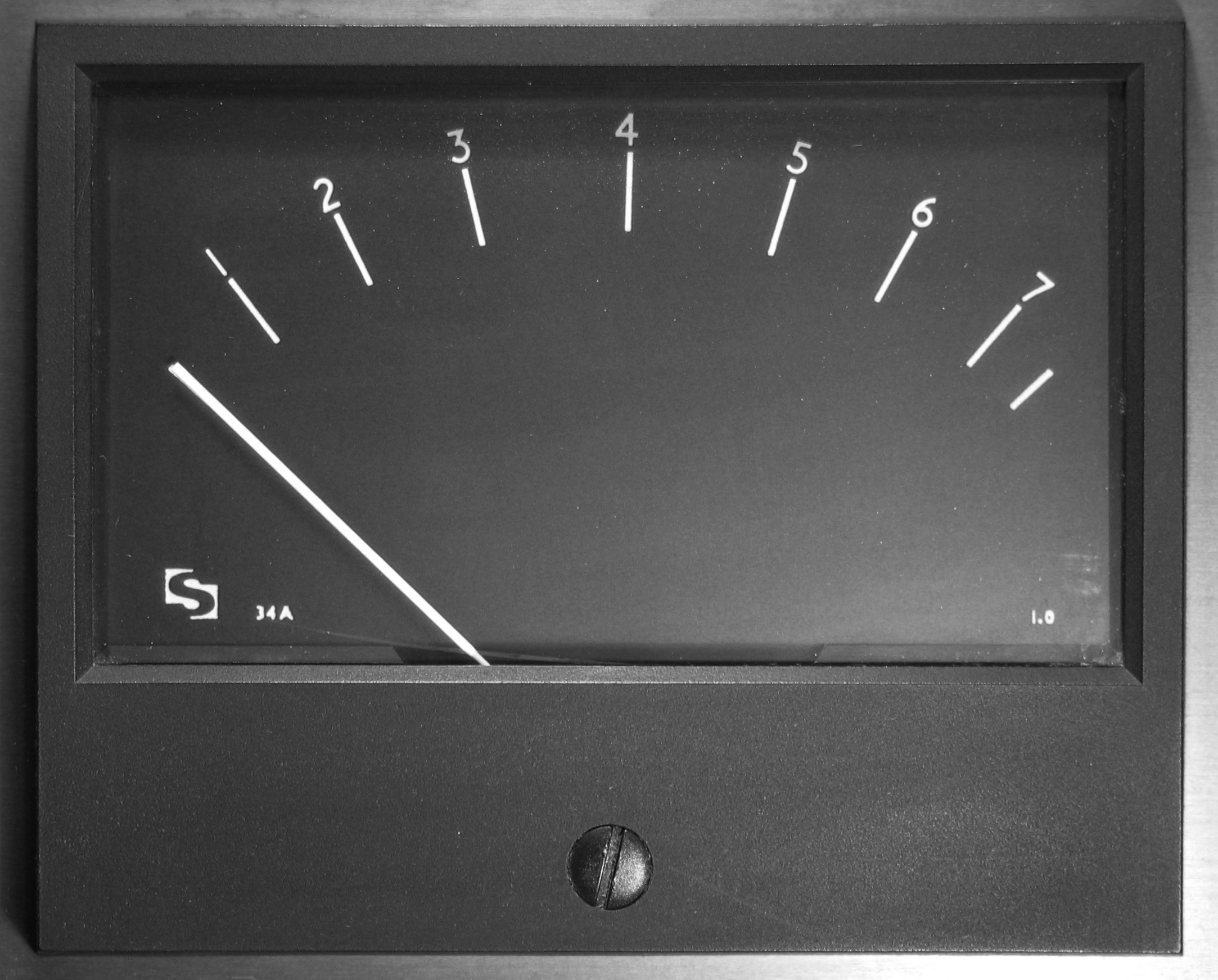|
Goniometer (audio)
A goniometer is often included in analog audio equipment to display a Lissajous figure which shows the amount of stereo (that is, phase differences) in a dual-channel signal. It allows the sound technician to adjust for optimal stereo and determine the makeup of errors such as an inverted signal. Many goniometers also provide a VU or PPM as a secondary function. A goniometer adapted for surround metering is called a 'jellyfish display'. This term was coined by DK-Technologies A/S from Denmark. Function Its function is to plot a signal on a two-dimensional area so that the correlation between the two axes (audio channels, or phases) becomes apparent. The channels are plotted on diagonal axes; a left-channel-only signal would form a diagonal line running top-left to bottom-right and a right-channel-only signal would form the opposite diagonal running top-right to bottom-left. A signal on both channels would provide components on both axes and thus expand the plot into two dimens ... [...More Info...] [...Related Items...] OR: [Wikipedia] [Google] [Baidu] |
Analog Circuit
Analogue electronics ( en-US, analog electronics) are electronic systems with a continuously variable signal, in contrast to digital electronics where signals usually take only two levels. The term "analogue" describes the proportional relationship between a signal and a voltage or current that represents the signal. The word analogue is derived from the el, word ανάλογος (analogos) meaning "proportional". Analogue signals An analogue signal uses some attribute of the medium to convey the signal's information. For example, an aneroid barometer uses the angular position of a needle as the signal to convey the information of changes in atmospheric pressure. Electrical signals may represent information by changing their voltage, current, frequency, or total charge. Information is converted from some other physical form (such as sound, light, temperature, pressure, position) to an electrical signal by a transducer which converts one type of energy into another (e ... [...More Info...] [...Related Items...] OR: [Wikipedia] [Google] [Baidu] |
Sound
In physics, sound is a vibration that propagates as an acoustic wave, through a transmission medium such as a gas, liquid or solid. In human physiology and psychology, sound is the ''reception'' of such waves and their ''perception'' by the brain. Only acoustic waves that have frequencies lying between about 20 Hz and 20 kHz, the audio frequency range, elicit an auditory percept in humans. In air at atmospheric pressure, these represent sound waves with wavelengths of to . Sound waves above 20 kHz are known as ultrasound and are not audible to humans. Sound waves below 20 Hz are known as infrasound. Different animal species have varying hearing ranges. Acoustics Acoustics is the interdisciplinary science that deals with the study of mechanical waves in gasses, liquids, and solids including vibration, sound, ultrasound, and infrasound. A scientist who works in the field of acoustics is an ''acoustician'', while someone working in the field of ... [...More Info...] [...Related Items...] OR: [Wikipedia] [Google] [Baidu] |
Lissajous Figure
A Lissajous curve , also known as Lissajous figure or Bowditch curve , is the graph of a system of parametric equations : x=A\sin(at+\delta),\quad y=B\sin(bt), which describe the superposition of two perpendicular oscillations in x and y directions of different angular frequency (''a'' and ''b).'' The resulting family of curves was investigated by Nathaniel Bowditch in 1815, and later in more detail in 1857 by Jules Antoine Lissajous (for whom it has been named). Such motions may be considered as a particular of kind of complex harmonic motion. The appearance of the figure is sensitive to the ratio . For a ratio of 1, when the frequencies match a=b, the figure is an ellipse, with special cases including circles (, radians) and lines (). A small change to one of the frequencies will mean the x oscillation after one cycle will be slightly out of synchronization with the y motion and so the ellipse will fail to close and trace a curve slightly adjacent during the next orbi ... [...More Info...] [...Related Items...] OR: [Wikipedia] [Google] [Baidu] |
Stereo
Stereophonic sound, or more commonly stereo, is a method of sound reproduction that recreates a multi-directional, 3-dimensional audible perspective. This is usually achieved by using two independent audio channels through a configuration of two loudspeakers (or stereo headphones) in such a way as to create the impression of sound heard from various directions, as in natural hearing. Because the multi-dimensional perspective is the crucial aspect, the term ''stereophonic'' also applies to systems with more than two channels or speakers such as quadraphonic and surround sound. Binaural sound systems are also ''stereophonic''. Stereo sound has been in common use since the 1970s in entertainment media such as broadcast radio, recorded music, television, video cameras, cinema, computer audio, and internet. Etymology The word ''stereophonic'' derives from the Greek (''stereós'', "firm, solid") + (''phōnḗ'', "sound, tone, voice") and it was coined in 1927 by Western E ... [...More Info...] [...Related Items...] OR: [Wikipedia] [Google] [Baidu] |
Phase (waves)
In physics and mathematics, the phase of a periodic function F of some real variable t (such as time) is an angle-like quantity representing the fraction of the cycle covered up to t. It is denoted \phi(t) and expressed in such a scale that it varies by one full turn as the variable t goes through each period (and F(t) goes through each complete cycle). It may be measured in any angular unit such as degrees or radians, thus increasing by 360° or 2\pi as the variable t completes a full period. This convention is especially appropriate for a sinusoidal function, since its value at any argument t then can be expressed as \phi(t), the sine of the phase, multiplied by some factor (the amplitude of the sinusoid). (The cosine may be used instead of sine, depending on where one considers each period to start.) Usually, whole turns are ignored when expressing the phase; so that \phi(t) is also a periodic function, with the same period as F, that repeatedly scans the same range ... [...More Info...] [...Related Items...] OR: [Wikipedia] [Google] [Baidu] |
VU Meter
A volume unit (VU) meter or standard volume indicator (SVI) is a device displaying a representation of the signal level in audio equipment. The original design was proposed in the 1940 IRE paper, ''A New Standard Volume Indicator and Reference Level'', written by experts from CBS, NBC, and Bell Telephone Laboratories. The Acoustical Society of America then standardized it in 1942 (ANSI C16.5-1942) for use in telephone installation and radio broadcast stations. Consumer audio equipment often features VU meters, both for utility purposes (e.g. in recording equipment) and for aesthetics (in playback devices). The original VU meter is a passive electromechanical device, namely a 200 µA DC d'Arsonval movement ammeter fed from a full-wave copper-oxide rectifier mounted within the meter case. The mass of the needle causes a relatively slow response, which in effect integrates or smooths the signal, with a rise time of 300 ms. This has the effect of averaging out peaks and ... [...More Info...] [...Related Items...] OR: [Wikipedia] [Google] [Baidu] |
Peak Programme Meter
A peak programme meter (PPM) is an instrument used in professional audio that indicates the level of an audio signal. Different kinds of PPM fall into broad categories: *True peak programme meter. This shows the peak level of the waveform no matter how brief its duration. *Quasi peak programme meter (QPPM). This only shows the true level of the peak if it exceeds a certain duration, typically a few milliseconds. On peaks of shorter duration, it indicates less than the true peak level. The extent of the shortfall is determined by the 'integration time'. *Sample peak programme meter (SPPM). This is a PPM for digital audio. It shows only peak sample values, not true waveform peaks (which may fall between samples and be up to 3 dB higher in amplitude). It may have either a 'true' or a 'quasi' integration characteristic. *Over-sampling peak programme meter. This is a sample PPM that first oversamples the signal, typically by a factor of four, to alleviate the problems of a bas ... [...More Info...] [...Related Items...] OR: [Wikipedia] [Google] [Baidu] |
Phase (waves)
In physics and mathematics, the phase of a periodic function F of some real variable t (such as time) is an angle-like quantity representing the fraction of the cycle covered up to t. It is denoted \phi(t) and expressed in such a scale that it varies by one full turn as the variable t goes through each period (and F(t) goes through each complete cycle). It may be measured in any angular unit such as degrees or radians, thus increasing by 360° or 2\pi as the variable t completes a full period. This convention is especially appropriate for a sinusoidal function, since its value at any argument t then can be expressed as \phi(t), the sine of the phase, multiplied by some factor (the amplitude of the sinusoid). (The cosine may be used instead of sine, depending on where one considers each period to start.) Usually, whole turns are ignored when expressing the phase; so that \phi(t) is also a periodic function, with the same period as F, that repeatedly scans the same range ... [...More Info...] [...Related Items...] OR: [Wikipedia] [Google] [Baidu] |
Monophonic Sound
Monaural or monophonic sound reproduction (often shortened to mono) is sound intended to be heard as if it were emanating from one position. This contrasts with stereophonic sound or ''stereo'', which uses two separate audio channels to reproduce sound from two microphones on the right and left side, which is reproduced with two separate loudspeakers to give a sense of the direction of sound sources. In mono, only one loudspeaker is necessary, but, when played through multiple loudspeakers or headphones, identical signals are fed to each speaker, resulting in the perception of one-channel sound "imaging" in one sonic space between the speakers (provided that the speakers are set up in a proper symmetrical critical-listening placement). Monaural recordings, like stereo ones, typically use multiple microphones fed into multiple channels on a recording console, but each channel is " panned" to the center. In the final stage, the various center-panned signal paths are usually mixed ... [...More Info...] [...Related Items...] OR: [Wikipedia] [Google] [Baidu] |
Musical Tone
Traditionally in Western music, a musical tone is a steady periodic sound. A musical tone is characterized by its duration, pitch, intensity (or loudness), and timbre (or quality). The notes used in music can be more complex than musical tones, as they may include aperiodic aspects, such as attack transients, vibrato, and envelope modulation. A simple tone, or pure tone, has a sinusoidal waveform. A complex tone is a combination of two or more pure tones that have a periodic pattern of repetition, unless specified otherwise. The Fourier theorem states that any periodic waveform can be approximated as closely as desired as the sum of a series of sine waves with frequencies in a harmonic series and at specific phase relationships to each other. The common denominator frequency, which is also often the lowest of these frequencies is the fundamental frequency, and is also the inverse of the period of the waveform. The fundamental frequency determines the pitch of the tone, ... [...More Info...] [...Related Items...] OR: [Wikipedia] [Google] [Baidu] |
Mixing Console
A mixing console or mixing desk is an electronic device for mixing audio signals, used in sound recording and reproduction and sound reinforcement systems. Inputs to the console include microphones, signals from electric or electronic instruments, or recorded sounds. Mixers may control analog or digital signals. The modified signals are summed to produce the combined output signals, which can then be broadcast, amplified through a sound reinforcement system or recorded. Mixing consoles are used for applications including recording studios, public address systems, sound reinforcement systems, nightclubs, broadcasting, and post-production. A typical, simple application combines signals from microphones on stage into an amplifier that drives one set of loudspeakers for the audience. A DJ mixer may have only two channels, for mixing two record players. A coffeehouse's tiny stage might only have a six-channel mixer, enough for two singer-guitarists and a percussionist. A n ... [...More Info...] [...Related Items...] OR: [Wikipedia] [Google] [Baidu] |









.jpg)